The Princesa de Asturias class were armoured cruisers ordered in 1887 as a repeat of the three Infanta Maria Teresa-class cruisers but with a more modern, more balanced armament and trying to improve on speed and protection. Princesa de Asturias, Cataluña and Cardenal Cisneros had very long construction time, as the lead ship was laid down in 1889, but she was only launched in 1896 and completed ever later in 1903 so a total of fourteen years. Her sisters fared a bit better. This post tries to explain why it happened, but the immediate result was their noticed absence at the 1898 Hispano-American war. It’s not sure if they would have done better, but their presence was for certain, lacking. They had by contrast a relatively uneventful and short career, Cardenal Cisneros being wrecked in 1905, so just two years after commission. Cataluña and Princesa de Asturias took part in WWI and were decommissioned in 1929-1930, despite the age of their design.

Development of the class
Based on the provisions of the 1887 Fleet Plan, a royal order of 17 September 1888 ordered the construction of three cruisers, improved Infanta María Teresa Class designs to gain time. Technically, these were “1st class protected cruisers”, the best thing aside ironclads. The term “armoured cruiser” was appropriate given the level of protection they had, and they really were a continuation, but with slight modifications, of the Infanta María Teresa Class armoured (or 1st class protected) cruisers. However all there were lost in the naval Battle of Santiago de Cuba in the Spanish-American War of 1898.
This happened when they were then under construction at the Ferrol shipyard and they took no part in the conflict. This fact stopped dead their construction, as it was waited for enough reports to mount evidence if their oprecedessor’s design was in any way, shape of form linked to their loss and underperformance in combat. In 1899 it was believed that not enough elements were substantial enough to point out a problem, apart perhaps speed. Overall, it appeared the Infanta Maria Teresa were mostly victims of circumstances. The way Cervera had to steam ahead in front of the US Navy “T” off Santiago played the bigger part as his ships were unable to deploy their broadside. If anything, the lack of speed was reportedly linked to poor coal quality, and lack of maintenance, not of the boilers and fooling of their hull, plus for combat performances, lack of gunnery training linked to a shortage of shells.
 This class was part originally of the naval plan of Admiral Alejandro Rodríguez Arias y Rodulfo. Their construction was approved by the Cortes (parliament) on January 12, 1887 and originally, they were to be simple repeats of the Infanta María Teresa class, but it was finally decided to change the design of this second trio, which construction was already behind schedule, so they needed more years of redesign. The advisory center of the Navy decided on November 6, 1895 to reduce their main artillery to 240 mm main guns, and increase protection of the secondary battery among other modifications.
This class was part originally of the naval plan of Admiral Alejandro Rodríguez Arias y Rodulfo. Their construction was approved by the Cortes (parliament) on January 12, 1887 and originally, they were to be simple repeats of the Infanta María Teresa class, but it was finally decided to change the design of this second trio, which construction was already behind schedule, so they needed more years of redesign. The advisory center of the Navy decided on November 6, 1895 to reduce their main artillery to 240 mm main guns, and increase protection of the secondary battery among other modifications.
Construction went on with some minor alterations and the class was now seen as a replacement for the former armoured cruisers. Delays however went way further than the 1898 war: The keel of the lead ship was laid on 1 September 1890. But construction did not actually begin until the launch of the cruiser Alfonso XII on 21 August 1891. This was due to shortage of personnel and materials, redirected to Alfonso XII.
Construction was halted in 1898 and resumed in 1999-1902 with modifications made to the design. The lead ship, Cardenal Cisneros, was launched indeed on 19 March 1897 but only entered service on 1 September 1902. Cardinal Cisneros was not the first to be laid down, this was Princesa de Asturias. So this explains the discrepancies between authors and publications about the class name. Whatever the delays and modifications or shortage, the result was that their completion was made quite late.
Cataluna was perhaps the worst case. She was laid down at SECN Cartagena in 1890 but only launched in September 1900, so ten years later, and commissioned (“asignado”) in 1903, although some sources states she was only completed in 1908, making for an amazing 18 years from keel laying to this or 21 years from order and initial design approval… Her sister were built in Ferrol and La Carraca.
In fact, after Cardinal Cisneros, Princesa de Asturias and Cataluña both really only operational in 1908. They were good ships but due to their construction beign so considerably delayed, they were technologically way behind more modern armoured cruisers. Any of these cruisers would have been smoked if facing any French, Italian, German, or British 1908 armoured cruiser. In 1906 HMS Dreadnought was launched, and the armoured cruiser breed was already considered dead. They were soon replaced by battlecruisers.

The most striking of these was the fate of Princesa de Asturias, built in the arsenal of La Carraca in Cádiz but which had a troubled launching, which required several attempts over several days, until finally launching herself thanks to high tides. For these reasons, popular humor gave Princesa de Asturias the nickname “the dragged one” as all attempts to launch her previously failed. And when she finally appeared floating she was nicknamed “the spontaneous one.” This became so popular as to end as verses at the Carnival of Cádiz in 1897.
Another unfortinate cruiser was the Cardinal Cisneros, which had the shortest operational life with perhaps the Japanese Unebi built in Bordeaux back in 1886, capsizing during her maiden voyage to the home islands. On October 28, 1905, only three years after her entry into service, Cisneros sank. In the official version at the time, as a result of grounding on an uncharting rock while heading for the Ferrol from the Noya estuary, near Muros, 35 km from Noya. A significant gash cause massivne flooding, which was impossible to master. Still, there were no fatalities, all evacuated with the help of local fishermen, other simply swam to shore, apart several injuries. Captain Manuel Díaz Iglesias was court martialled, suspended, and assigned to administrative tasks. In gratitude for the assistance provided, King Alfonso XIII granted Muros the title of “Very Humanitarian” a year later, featured on the municipal coat of arms ever since. Her two sister ships fared better, lasting until 1928, and see combat in the Rif war, in Morocco.
Design of the class
Hull and general design
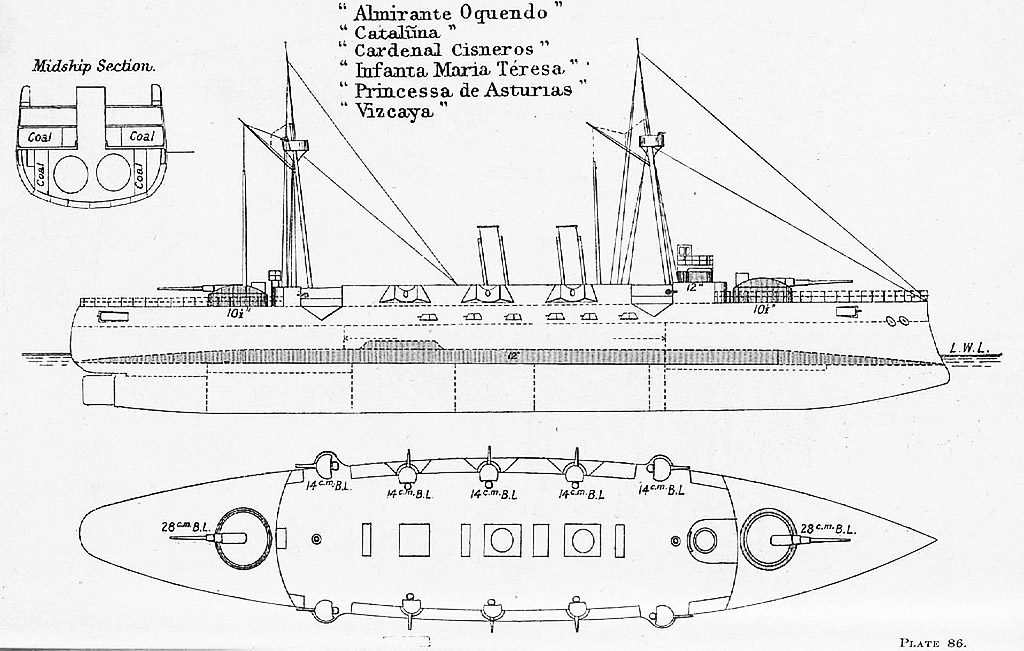
These ships were similar in shape and size to their precedessors, at 110.97 metres (364 ft 1 in) long, for a beam of 18.59 metres (61 ft), and draught of 6.61 metres (21 ft 8 in) and a ram bow. These proportions were coherent for 1887, giving them good stability, but not favourable to speed. They had a displacement of 6,888 tons.
Their silhouette was initially mirroring that of the Infanta Maria Teresa, with two funnels and tow raked masts with fighting tops, a flush deck hull with bulwarked amidship and casemated corner secondary guns, two main guns in barbettes fore and aft (Canet type), and lighter guns in lower battery casemates and fore and of the hull. Officers quarters were at the poom as usual, their bow was well decorated, and they had optional schooner rigging (never installed). They had a small bridge installed over a larger conning tower forward only. This was very much a XiXth design.
They were modified however after launch. The plans above were changed. The general hull was kept, but the superstructures were modified. They had a new primary armament fore and aft in turrets instead of Barbettes with Guillén M1896 ordnance, a new secondary armament with eight 140mm/33 Schneider-Canet, shielded in sponsons and lighter bulwarks, all lighter guns (eight 57mm/42 Nordenfelt) were now placed in the superstructures and the hull’s amidship casemates were eliminated, the fighting tops were relocated much lower, with two Maxim 37mm/27 light guns, and projector tops were added above. The masts were now devoid of any rigging idea and straight.

Rendition of Cataluna in 1906, in Navypedia.
The superstructures were much more developed. The bridge now was composed of a forward, howerhanging enclosed all weather navigation bridge, a map roombehind, an open bridge above with repeaters. Two more projectors were installed on either side of the forfunnel. There ws a more developed structure aft of the second funnel and another aft bridge afdt of the mast. It’s likely the officers quarters had been reloated closer to the bridge as well. The general outlook was far more modern.
Powerplant
Like the previous ships, they kept the same powerplant, completely obsolete by 1908 standards. They had originally two-shaft horizontal reciprocating (HTE) engines driving four-bladed old style propellers, fed by six cylindrical boilers. This was changed on Cisneros for two vertical triple expansion engines from “La Maquinista Terrestre y Marítima”, fed by four 2-ended boilers and 40 ovens. They were overall rated at 14,800 ihp (11,000 kW) for a top speed of 20-21 knots (37 km/h; 23 mph), only on forced heating. In natural draught this was closer to 19 knots (18 for the Infanta as built, 14-15 in 1898).
They carried also 1,180 tonnes of coal for a range of 6,500 nm at 10 knots.
Protection
It was essentually kept as it was on the original design, and quite good for their size and tonnage. The main difference was it was now modernized with Harvey steel. The belt still went up to 300 mm (12 inches), tapered down to 150 mm (6 inches) for the upper belt, main gun barbettes were 200 mm (7.88 in), main turrets were 99 mm (3.88 inches) thick, the conning tower was also walled by 200 mm (7.88 inches) plates, and the armoured deck reached 57 mm (2.25 inches) on its slopes. It was moderately turtle back and had a “hump” above the machinery as shown in plans. To be more precise, their main armour belt reached 11.88 in (30.2 cm).
Despite the better properties of the Harvey armour, armour coverage was not comprehensive and obsolete in scheme, so they ended were poorly armoured by standards of the day. They most importantly lacked armoured wells to communicate to the ammunition wells, and lacked any strong bulkhead or citadel, making their vulnerable to raking fire. In addition, they had no ASW protection whatsoever as shown by the loss of Cisneros.
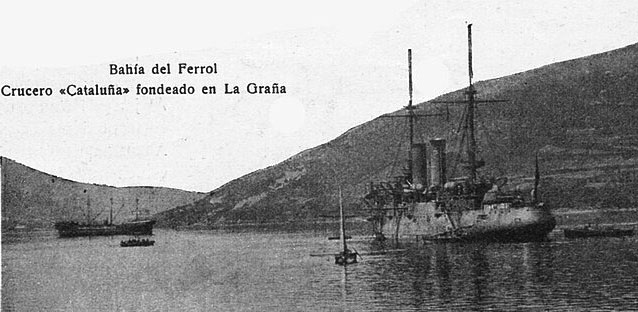

Two photos of Cataluna
Armament
As described above, their armament was the most revised aspect of the design. Instead of the old style Canet 28 cm (11.0 in)/35 guns they opeted for more modern Spanish models installed in proper turrets. The secondary battery was lighter, instead of ten 14 cm (5.5 in)/35 guns with poor range and rate of fire, they opted for eight more modern 140/33 Schneider-Canet guns. The lught battery was modernized as well.
240mm/41 Guillén M1896
In the mid-1890s, the Spanish Naval Ministry wanted to replace the obslete 28 cm Canet guns and Brigadier de Artilleria de la Armada Don Enrique Guillen with help from Schneider designed a more modern ordnance, still based on older Canet designs, with electric mountings. Cristobal Colon was the first armed with these, but they could ne be installed in time before she was sunk. A total of only six guns were built and delivered, two Schneider, the remainder at Carraca Arsenal. After the ships were discarded in 1928, they ended as coastal artillery. They were also planned for the Emperador Carlos V. Actual overall length was 42.5 calibers.
They weighted 22.5 tons (23 mt) not including the breech, fired a two-bagged AP 445.3 lbs. (202 kg) or 440.9 lbs (200 kg) common HE shell with a 165 lbs. (75 kg) CSP2 1 propellant charge at a muzzle Velocity of 2,997 fps (700 mps) and one shot per minute.
More
140mm/33 Schneider-Canet
Designed specifically for Spain, no data yet. They were located in eight poisitions, four either side: Two in corner sponsons, with better arc of fire and four in inner sponsons admidships, with lower fore arc. They were shielded against small arms fire and shrapnel.
57mm/42 Nordenfelt, 37mm/27 Maxim
All light guns were purchased from Maxim-Nordenfelt in UK. The 5.7 cm Maxim-Nordenfelt or “Canon de caponnière” was a fortress gun/infantry gun. Its naval variants specifics are not known, neither its locations due to the absence of plans. By analogy with the 6-pdr, it had a Vertical sliding-block with locking wedge and fired 2.7 k 57-millimetre (2.24 in) shells at a muzzle velocity of c1,800 ft/s (550 m/s) and range of 4,500–6,000 yd (4,100–5,500 m).
They were eight of the former, probably shielded, in singe mount positions, probably four in hull casemates and the rest in the wings fore and aft.
The 37mm/27 Maxim were basically the famous QF 1 pdr Mark I & II (“pom-pom”). It fired a 37 x 94R Common Shell 1-lb (0.45 kg), 37-millimetre (1.457 in) at ~300 rpm (cyclic) rate and a muzzle velocity of 1,800 ft/s (550 m/s) to 4,500 yards (4,110 m). Ten provided, at least four on the two fighting tops, the rest in the superstructures fore and aft, unshielded.
Torpedo Tubes
The cruisers were completed with the same tiorpedo tibes arrangement as the previous vessels, five 450mm TT (18 inches) whitehead, one in the bow, four in the beam.
⚙ specifications |
|
| Displacement | 6,888 tons |
| Dimensions | 110.97 x 18.59 x 6.61 m (364 ft 1 inx 61 ft x 21 ft 8 in) |
| Propulsion | 2 shafts HTE, 4 boilers, 14,800 hp (11,000 kW) |
| Speed | 20 knots (37 km/h; 23 mph) |
| Range | 1,180t coal, 6,500 nm/10 kts |
| Armament | 2× 9.4 in (24 cm), 8 × 5.5 in (14 cm), 8 × 57 mm (2.2 in)/42, 5 TTs |
| Protection | 30.2 cm belt, 20 cm barbette, CT, 9.9 cm turrets, 5.7 cm deck |
| Crew | 542 |
Career of the Princesa de Asturias class
 Princesa de Asturias (1903)
Princesa de Asturias (1903)
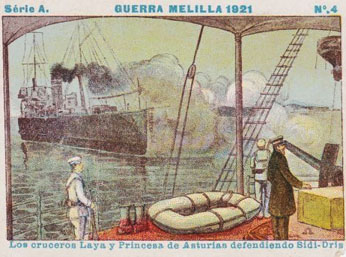 Her keel was laid at Arsenal de la Carraca on September 23, 1889 but the first attempt to launch her on September 9, 1896 failed: She slided rapidly towards the sea, but stopped just aft 14-15 meters from her starting point. Work was done to solve possible causes and another attmped was made on October 8, aiting also for higher tides. This time she barely made 20 meters before stopping, with her stern protruding 36 meters outside the slipway, which was a danger to her structure. Decision was made to place floats under her stern to support her. The hope was also she could ne secured at low tide, not move. Work continued and she ws launched agains on Saturday 9 October, left with her stern in the water by just 25 metres. This was attempted again on 5 November as major tide was awaited. On 17 October 1896 this was alone wthout any decision of effort to be floated out.
Her keel was laid at Arsenal de la Carraca on September 23, 1889 but the first attempt to launch her on September 9, 1896 failed: She slided rapidly towards the sea, but stopped just aft 14-15 meters from her starting point. Work was done to solve possible causes and another attmped was made on October 8, aiting also for higher tides. This time she barely made 20 meters before stopping, with her stern protruding 36 meters outside the slipway, which was a danger to her structure. Decision was made to place floats under her stern to support her. The hope was also she could ne secured at low tide, not move. Work continued and she ws launched agains on Saturday 9 October, left with her stern in the water by just 25 metres. This was attempted again on 5 November as major tide was awaited. On 17 October 1896 this was alone wthout any decision of effort to be floated out.
Fitting out still was a protracted affair. From January 29, 1903, she performed her sea trials off Cadiz, and was commissioned on June 10, thirteen years after her construction started. On June 22, 1903, she sailed with Emperador Carlos V, Cardenal Cisneros and Extremadura, Pelayo, Numancia and the destroyer Audaz to Cartagena for Alfonso XIII’s visit.
Until mid-October 1904, she carried out naval exercises on the Cantabrian coast together with the Pelayo, the Cardenal Cisneros, the protected cruiser Río de la Plata, the destroyer Audaz and the gunboat Álvaro de Bazán.
On 3 November with the training squadron, she anchored in La Coruña, near Ferrol with the Pelayo, Cisneros and Río de la Plata and two gunboats before training in the Galician waters and visiting Corcubión, Muros, Villagarcía, Marín and Vigo, to be joined here bt Extremadura and Audaz. On November 29 she sailed to the Cíes Islands for her first live firing drills but two gunners were wounded, other bruised by unexpected recoil of the main guns. The saudron sailed next to Cádiz.
On January 13, 1905, Princesa de Asturias and the squadron hosted the Duke and Duchess of Connaught when visiting Cádiz, arriving from the cruiser HMS Essex.
On February 5, 1905, Princesa de Asturias stayed at Santa Cruz de Tenerife and stayed until the 25th.
In April 1906, she escorted Alfonso XIII on his first trip as monarch to the Canary Islands. On July 30 she sailed for Cowes, Isle of Wight, escorting the royal yacht Giralda. She arrived on August 1, and on the 13th sailed for Southampton, the royal hosts continued by train to Scotland. On the 20th. She escorted them back from Southampton to Cowes, and San Sebastián when ordered to sail to Bilbao and join the rest of the fleet on July 24.
On November 3rd it was in Malaga and later Tangier, and stayed for several months as the situation degraded in Morocco.
On April 8, 1907 she escorted King Alfonso XIII for royal summit off Cartagena with King Edward VII. On June 20-21 she took part in naval exercises in the Vigo estuary with Pelayo, DDs Osado and Proserpina under Rear Admiral Padriñan defending against the attacking force from Mahón, with Princesa de Asturias, Extremadura and Río de la Plata (Rear Admiral Morgado). They won.
On January 17, 1908, Princesa de Asturias sailed for Rabat, with instructions from the government the Moroccan capital. She was delayed by a strong storm and most important instruction were delivered by flag telegraph. On the 28th, the Spanish embassy boarded her, as she eventually entered Tangier. On February 2 she landed the Spanish embassy in Cadiz and headed for Lisbon, after the King of Portugal and Crown Prince had been assassinated. She was back in Cadiz on the 15th.
She sailed to Messina late 1908 for assistance after an earthquake, with official aid voted by the Cortes.
On July 29, 1909, she was in Barcelona with Carlos V and DDs Osado, Audaz and Proserpina, crossed the Strait of Gibraltar and on August 2, 1909, went back to the southern dock, Barcelona.
On 13 August 1909, she was ordered to Melilla and then Mar Chica to bombard shore objectives held by leaders of the Chaldi insurrection. On 18 August 1909 she shelled Nador and Ibarraben as well as Zoco de Yemas along with Carlos V, Extremadura, Numancia, Pinzón and General Concha. She stayed under orders for cover fire in what later became the Rif war.
On August 19, 1909, the squadron was split, and she ended in the first (Rear Admiral Morgado) with Carlos V, Numancia, Extremadura, Osado, Pinzón and Almirante Lobo. On August 28, informed that the batteries in Mar Chica had been silenced after she launched a landing party. She withdrawn and sailed to Chafarinas after her low-pressure cylinder, port engine broken down, middle cylinder and distributors over ten days. Two boats armed with Vickers/Maxim cannons and a motor boat from Carlos V became the main landing party at Mar Chica. On September 6 she was back to Cartagena to recoal and on the 13th, returned for another landing party at Mar Chica and on October 1, was back in Melilla. 4 days latee she shelled enemy positions in Punta Negri and Boca del León and on the 7-10 she sailed along the western coast of Tres Forcas, shelling Beni-bu-Gafar and Beni-Said. On November 2, because of a storm she lost a boat and she withdrew to Chafarinas.
On November 26, she retruned to Cadiz, ending her Melilla campaign.
In October 1910 she was with Numancia in Lisbon, as the Portuguese revolution flared up, and was back in Cadiz on November 11.
On 8 January 1911, Alfonso XIII visited Melilla and she escorted the royal yacht Giralda. On 14 February, she trained with the squadron for the King off Alicante.
By late April, the French intervention in Morocco forced to order the training squadron in Cádiz. Marine infantry were also concentrated there and took part in landing exercises. On May 5, she sailed for Las Palmas and on October 15, she was back in Melilla. On the 20th with Reina Regente she shelled positions in the vicinity of Trafats. On the 21st she was refitted and recoaled at Cartagena. On 6 November with Pelayo and Recalde, she shelled positions at Alhucemas and supported the army until the end of the year, retiring in Cartagena.
On the 8 January 1912, she was back in Melilla and on the 19th assisted Reina Regente, which had run aground on a sandbank near Kert. On the 17th she was back in Cadiz and on the 22nd of March she supported the armr in the mouth of the Kert, Benisidel and Benibugafar. On the 27th, Monte Mauro and and later the left bank of the Kert River. In July, she escorted the yacht Giralda to the Cantabrian coast. On September 5 she was in Ferrol to have all her boilers repaired. On the 20th, she was back to Cádiz.
On March 13-16, 1913 she had life fire drills off the Cantabrian coast and Torre García, and back to Cadiz. She assisted to the launching ceremony of the new battleship Alfonso XIII. In May she headed for her longest trip, to Istanbul, replacing Reina Regente, as part of the international squadron protecting Spanish nationals in Turkey as the Greco-Turkish war flared up.
On October 2nd at the occasion of an official visit of French president Poincaré, the training squadron took part in a review in Cartagena and attended the ceremony of delivering the battleship España’s combat flag. They were back to Africa but Princesa stayed mostly in Cadiz.
During the First World War, she visited Las Palmas and Barcelona. On 19 October 1916 while in Las Palmas, her marine infantry detachment boarded the Greek steamer Andrea Jerakis, which rebelled after not being not given a pay increase, later imprisoned. She rescued 17 crew members of the Portuguese ship Emilia sunk by an U-Boat, already picked up by a felucca.
Postwar she returned to Morocco, rescued the garrison of Sidi Dris under siege on 25 July 1921 and a party reinforced the fortification of Afrau. On 25 August 1921, she shelled Riffians marching on Punta Restinga. On September 9, she shelled enemy positions in the El Arbaa and El Arkemán souks. On the 16th with España, she shelled Barraca hill. On her return the admiralty considered her obsolete ship and she was placed in reserve until decommissioned on December 28, 1927, stricken in 1930, sold for BU in 1933.
 Cardenal Cisneros (1903)
Cardenal Cisneros (1903)
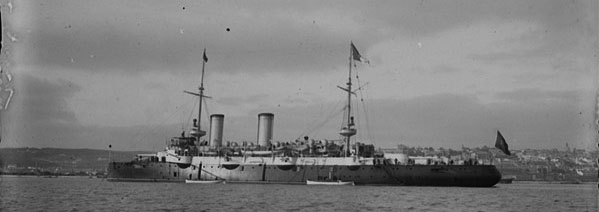
Cisneros in Portugal.
Cardinal Cisneros was authorized on 12 January 1887, launched on 1 September 1890, construciton postponed, redesigned, rerplaced in drydock, relaunched on 19 March 1897 and Commissioned 30 March 1903. On 1-15 August 1902 she had her sea trials. On 23 October when her crew tried to moor her in front of the old dock at the arsenal she hit a stone shoal. On 22 June 1903 she departed with her sister and other ships for a visit Alfonso XIII, before manoeuvres off Cartagena, and sailed for Lisbon, anchored at the mouth of the Tagus for the King’s visit.
In April-May 1904 she escorted the royal yacht Giralda to visit various Spanish ports. On April 21 with Lepanto she sailed to Palma de Mallorca from Mahón, then Almería but a strong storm forced her in Chafarinas Islands. She was at Málaga and on May 2, Melilla with Giralda, and Chafarinas, then Ceuta, and back to Cadiz, then Huelva and the mouth of the Guadalquivir, and Seville.
On January 13, 1905, she was present for the Duke and Duchess of Connaught visit to Cadiz and on February 5-25, was in Santa Cruz de Tenerife.
In April she paid tribute to the deceased Emperor Wilhelm II during his visit to Mahón from Tangiers and escorted the transatlantic ship Hamburg and SMS Friedrich Carl, saluted by the coastal artillery and Numancia. Cisneros escorted Giralda for Castellón, and Alicante.
In June she sailed to France and Great Britain, escorting Giralda to Cherbourg and Portsmouth, back to Ferrol on the 19th.
As part of the naval training division she was in training in the Galician estuaries, on October 28, from Muros bound for Ferrol to repair minor boiler issues. When 2.6 miles from the Meixidos shoals, she hit an uncharted reef, tearing down more than 50 meters plating of her hull. The entire boiler room and part of the forward engine room were flooded. But the flooding continued as the thin bulkheads did not hold, still was controlled enogh to give time for the entire crew to be saved. She sank by the bow. The captain forgot to pick up the logbook on which was the exact location and was court martialled, sentenced to a year suspension from employment, negligence but overall cleared of charges for the loss as the maps indeed did not reported the reef. In September 2006, the wreck was redicovered by divers José Manuel Silva, Juan Montero and Unai Artaloitia.
 Cataluña (1903)
Cataluña (1903)
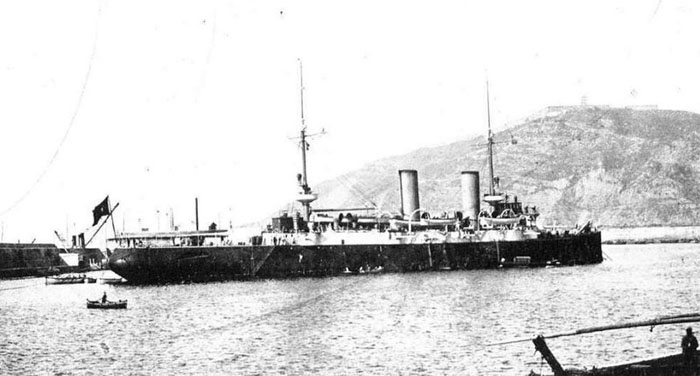
Cataluna in Barcelona
Cataluna was authorized on 12 January 1887, launched on 1890 and re-launched on 24 September 1900, then commissioned in 1903, then again in 1903, participating alongside Princess of Asturias in the Rif War.
On January 8, 1911, she was present when Alfonso XIII visited Melilla, escorting Giralda. By late April, the French intervention in Morocco and fearing incidents, the fleet was deplyed there: Princesa de Asturias, Carlos V, Reina Regente, Extremadura, Río de la Plata, Infanta Isabel, 2 destroyers and 2 gunboats from Cartagena. Cataluña carried Marine infantry from Cádiz and took part in landing exercises at Larache. On May 5, she sailed with Río de la Plata for Las Palmas.
In July with Carlos V she escorted Giralda to the Cantabrian coast. On September 5 she was in Ferrol towing the destroyer Terror having all her boilers disabled. On September 20, 1912 she was in Cadiz for training.
On March 13-16, 1913, she had life firing exercises off Torre García. She sailed to Ferrol for the launching ceremony of Alfonso XIII. On October 2nd she was present for the review held in hornor of French president Poincaré in Cartagena. She tookpart in all operations of the Rif war after her sister postwar and in the First World War between June 21 and 22, 1916, she had SM U-35 anchored next to it, carriying a message from the Kaiser trying to rally Spain to the central Empires. She was decommissioned in 1928, already in reserve after 1922, and scrapped in 1930.
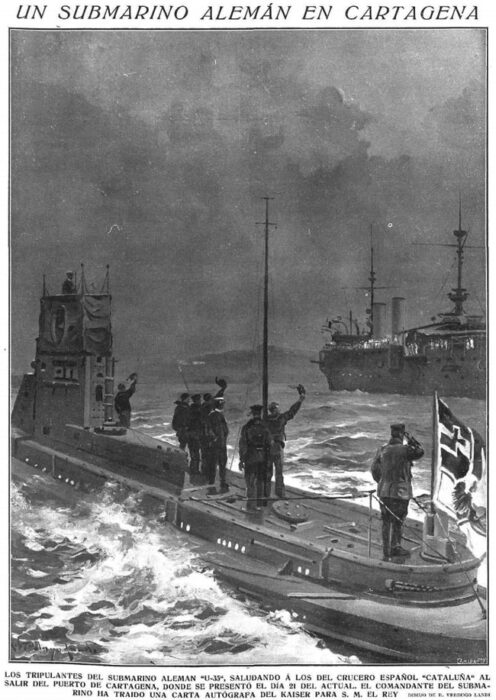
German submarine U-35 in Cartagena, delivering an important message from the kaiser to the Spanish King via the cruiser Cataluna.
Read More/Src
Books
Journal ASNE (1896). “Ships”. Journal of the American Society of Naval Engineers. 8 (1).
Chesneau, Roger, and Eugene M. Kolesnik, Eds. Conway’s All The World’s Fighting Ships 1860–1905.
Fitzsimmons, Bernard. “Carnenal Cisneros”. Purnell’s Illustrated Encyclopedia of Modern Weapons and Warfare.
Datos técnicos: El Lebaril, Diario de Unión Republicana (Mahón). 14 de septiembre de 1896.
Coello, Juan Luis; Agustín R. Rodríguez (2001). Buques de la Armada Española a través de la fotografía 1849-1900
Links
armada.defensa.gob.es
diariodecadiz.es/
lavozdegalicia.es
on navypedia.org/
web.archive.orgislabahia.com/
todoavante.es Princesa_de_Asturias_(1903)
todoavante.es Cataluna_(1908)
vidamaritima.com/ los-cruceros-…
solopecios.com Recortes
la-ilustracion-espanola-y-americana–797.pdf
abc.esl
blancorincon.com luces_y_sombras.htm
es.wikipedia.org Clase_Cardenal_Cisneros
Princesa_de_Asturias_(1903)
Cataluna_(1903)
Cardenal_Cisneros_(1903)

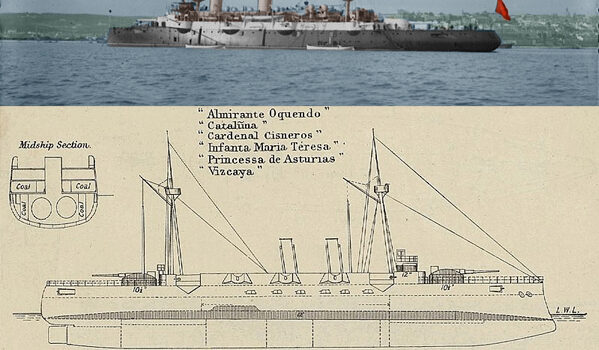

 Latest Facebook Entry -
Latest Facebook Entry -  X(Tweeter) Naval Encyclopedia's deck archive
X(Tweeter) Naval Encyclopedia's deck archive Instagram (@navalencyc)
Instagram (@navalencyc)





 French Navy
French Navy Royal Navy
Royal Navy Russian Navy
Russian Navy Armada Espanola
Armada Espanola Austrian Navy
Austrian Navy K.u.K. Kriegsmarine
K.u.K. Kriegsmarine Dansk Marine
Dansk Marine Nautiko Hellenon
Nautiko Hellenon Koninklije Marine 1870
Koninklije Marine 1870 Marinha do Brasil
Marinha do Brasil Osmanlı Donanması
Osmanlı Donanması Marina Do Peru
Marina Do Peru Marinha do Portugal
Marinha do Portugal Regia Marina 1870
Regia Marina 1870 Nihhon Kaigun 1870
Nihhon Kaigun 1870 Preußische Marine 1870
Preußische Marine 1870 Russkiy Flot 1870
Russkiy Flot 1870 Svenska marinen
Svenska marinen Søværnet
Søværnet Union Navy
Union Navy Confederate Navy
Confederate Navy Armada de Argentina
Armada de Argentina Imperial Chinese Navy
Imperial Chinese Navy Marinha do Portugal
Marinha do Portugal Mexico
Mexico Kaiserliche Marine
Kaiserliche Marine 1898 US Navy
1898 US Navy Sovietskiy Flot
Sovietskiy Flot Royal Canadian Navy
Royal Canadian Navy Royal Australian Navy
Royal Australian Navy RNZN Fleet
RNZN Fleet Chinese Navy 1937
Chinese Navy 1937 Kriegsmarine
Kriegsmarine Chilean Navy
Chilean Navy Danish Navy
Danish Navy Finnish Navy
Finnish Navy Hellenic Navy
Hellenic Navy Polish Navy
Polish Navy Romanian Navy
Romanian Navy Turkish Navy
Turkish Navy Royal Yugoslav Navy
Royal Yugoslav Navy Royal Thai Navy
Royal Thai Navy Minor Navies
Minor Navies Albania
Albania Austria
Austria Belgium
Belgium Columbia
Columbia Costa Rica
Costa Rica Cuba
Cuba Czechoslovakia
Czechoslovakia Dominican Republic
Dominican Republic Haiti
Haiti Hungary
Hungary Honduras
Honduras Estonia
Estonia Iceland
Iceland Eire
Eire Equador
Equador Iran
Iran Iraq
Iraq Latvia
Latvia Liberia
Liberia Lithuania
Lithuania Mandchukuo
Mandchukuo Morocco
Morocco Nicaragua
Nicaragua Persia
Persia San Salvador
San Salvador Sarawak
Sarawak Uruguay
Uruguay Venezuela
Venezuela Zanzibar
Zanzibar Warsaw Pact Navies
Warsaw Pact Navies Bulgaria
Bulgaria Hungary
Hungary

 Bundesmarine
Bundesmarine Dutch Navy
Dutch Navy Hellenic Navy
Hellenic Navy Marina Militare
Marina Militare Yugoslav Navy
Yugoslav Navy Chinese Navy
Chinese Navy Indian Navy
Indian Navy Indonesian Navy
Indonesian Navy JMSDF
JMSDF North Korean Navy
North Korean Navy Pakistani Navy
Pakistani Navy Philippines Navy
Philippines Navy ROKN
ROKN Rep. of Singapore Navy
Rep. of Singapore Navy Taiwanese Navy
Taiwanese Navy IDF Navy
IDF Navy Saudi Navy
Saudi Navy Royal New Zealand Navy
Royal New Zealand Navy Egyptian Navy
Egyptian Navy South African Navy
South African Navy






























 Ukrainian Navy
Ukrainian Navy dbodesign
dbodesign